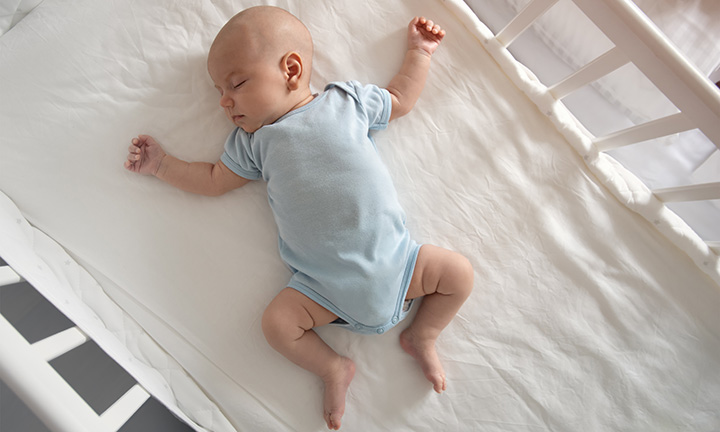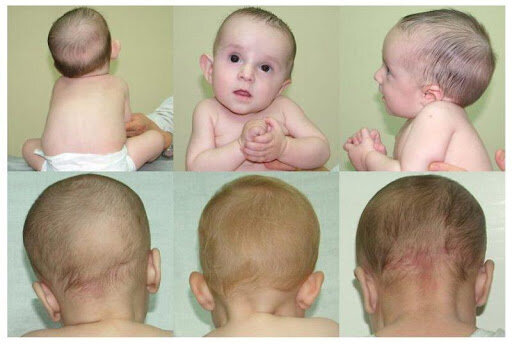Babies sleep a lot, and as a parent, you need to ensure your child sleeps in a safe position. A safe position is the position defined by the American Academy of Pediatrics that prevents SIDS (sudden infant death syndrome), which is a terrifying thing that may happen where a child may just die for no reason. So if you have an infant at home, it is essential that you know everything about the ideal sleeping positions for babies. However, the best sleeping positions for babies is a widely debated topic. Let’s look at some common sleep positions and discuss which one is best and safe for babies.

Sleep on Back
The sleep on back position is the safest and the best sleeping position for infants. It is the most suggested sleeping position for babies. When babies are put to sleep on their back, the position of the airways and nose are all exposed for easy breathing. So it has the minimal risk of suffocation, even in a case of small spit up, with the baby on the back, the airway still remains open. The sleep on back position is recommended for short naps and for sound sleep throughout the night for babies.
What if the baby is not comfortable sleeping on his back?
Safety is of a higher priority than comfort. Make your baby sleep on his back from an early age, so he is comfortable in what position.
Sleep on the Side
Is Sleeping on the Side Safe for Babies?
Sleeping on the side is not a safe option for children, as it can directly lead to a number of health conditions in the child. Such as:
1.Harlequin Colour Change – In this condition, the side on which the baby sleeps becomes pink or red, while the other hair remains unaffected. This is benign, and the colour fades away soon after switching sides.

This usually occurs due to gravity affecting blood flow in the immature blood vessels of the child, causing accumulation of red blood cells near the skin.
What are the treatments?
No treatment is required for this condition, as the colours fade away minutes after the position of the child is changed.
2.Flatheads- Flatheads occur when pressure on one part of the skull causes it to flatten or sink inwards. This improper shape may result in limited brain expansion, leading to stunted brain growth.
What are the treatments?
The treatment consists of using braces called baby helmets to correct the problem. These help reposition the skull of the child.
- Torticollis – Torticollis is characterized by abdominal tilting of the neck in one direction, due to repeatedly sleeping on one side or turning the head in an awkward position.
What are the treatments?
Muscle stiffness can be released via physical therapy or wearing a recovery harness, which is wrapped around the baby’s body and has a soft pad which brings the neck to normal position.

4.Risk of Choking – In some cases, regulated food can get accumulated near the tracheal opening, and this results in another choking hazard. Torsion is created in the windpipe, which makes breathing difficult for the child. Tummy sleeping is more likely when the baby sleeps on his side, which can increase the risk of SIDS.
What are the treatments?
There is no treatment for this. The best thing to do is to prevent your child from sleeping on his side.
Ways to prevent your baby from sleeping on his side:
- Place Your Baby on the Back
Place him on his back when you put him to sleep whether it be his crib or his cradle. - Remove Unnecessary Support Structures
Remove items that negatively affect the baby’s sleep in any way, such as crib bumpers or pillows. - No Sleep Positioners
Sleep positioners or wedges are designed to ensure that your child sleeps on his side, so remove them. - Reduce Swaddling
Swaddling creates a cylindrical surface around the baby, which makes it easy for him to roll over in his sleep. Reduce swaddling and, therefore, the risk of SIDS.
Sleep on Stomach
The sleep on stomach position for babies is highly unsafe for the following reasons:
- This position may put some pressure on the baby’s jaws and block the airways, making it difficult for the baby to breathe.
- Sleeping on the stomach makes the baby lie with his face very close to the sheet, making him breathe the same air. This may result in breathing in recycled air, which is low in oxygen.
- Sleeping on the stomach on a very soft mattress may cause suffocation in the baby.
- Because the nose is placed very close to the mattress in this position, the baby ends up breathing in the microbes present in the sheet covering the mattress.

Tips for safe baby sleep.
1.Use a firm mattress for the baby’s bed.
A firm bed is ideal for babies. Also, the use of bumper pads, pillows, or soft toys inside the baby’s crib must be avoided as it may accidentally cover the baby’s head.
- Keep the room cool at night.
It is also suggested that children be put to sleep in a cool environment, preferably 20 degrees centigrade.
- Use a baby monitor.
The monitor helps them keep a watch on the baby from anywhere in the house, especially for parents who cannot be around the baby at all times.
- Night clothes should be light clothes.
It’s important to dress the baby in light clothes for a good night’s sleep. ensure the clothes are not too tight and not too loose.
- share the same room.
Installing the baby’s crib in the same room as the parents makes breastfeeding convenient, and it’s easy for the parents to keep a close watch on the baby’s sleeping positions. newborn babies are prone to sit and silly on account of incorrect sleeping positions. It is therefore essential to know about various sleeping positions and the risks they pose to newborns.
A baby must not be allowed to lie on his tummy or side during the first year, so ensure that you use the above tips to inculcate good sleeping habits in your little one.

